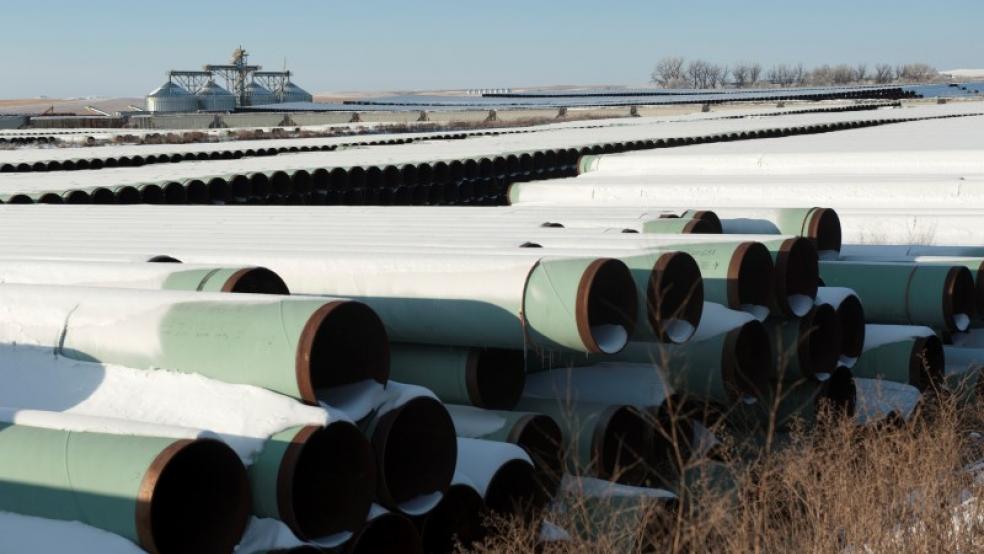President Donald Trump moved to fulfill one of his campaign promises on Tuesday, signing an executive order to revive the Keystone XL and Dakota Access Pipelines. The former had been rejected outright by the Obama administration while the latter had been given an indefinite delay.
The industry hailed the executive order, but just because President Trump wants to see the pipeline built does not mean TransCanada will move to break ground anytime soon. There are a number of uncertainties that could prevent construction from progressing.
Related: Environmentalists’ Worst Fears About Trump Are Coming True
First, the President said that he would “renegotiate” the terms of the Keystone XL pipeline, presumably to get a “better deal” as he promised during the campaign. The specifics of “renegotiating” the pipeline are unclear – he also signed an executive order to expedite the environmental review process for major infrastructure projects, so it is not as if he has a problem with the pipeline’s route or environmental impact. “The regulatory process in this country has become a tangled mess,” President Trump said.
Based on his comments during the presidential campaign, it would appear that he wants to ensure some of the oil flowing through the Keystone XL Pipeline would be consumed in the U.S. rather than be shipped to the Gulf of Mexico for export. Again, it is unclear what kind of requirements he wants to place on the project and how that might complicate the calculations for TransCanada.
Another complicating factor for the project is that President Trump signed a separate order calling for all pipelines to be constructed with American-made steel. If that order is binding on TransCanada, it is uncertain how that will affect the ultimate cost of the project.
Meanwhile, environmental groups argue that the executive order does not resolve all legal questions surrounding both pipelines and have promised to resume the fight against the project. “President Trump appears to be ignoring the law, public sentiment and ethical considerations with this executive order aimed at resurrecting the long-rejected Keystone XL pipeline,” Trip Van Noppen, President of environmental group Earthjustice wrote in a statement. “He should brace himself to contend with the laws he is flouting, and the millions of Americans who are opposed to these dangerous and destructive projects. We will see his administration in court.”
Related: Quick action Trump could take on energy, environment, climate
On top of that, President Trump is proposing a border-adjustment tax as part of his larger tax reform push for this year. The idea is that products exported from the U.S. will be exempted from tax while at the same time companies will no longer be able to deduct the expenses of imports from their tax bill. The proposal is highly controversial and it would have huge ramifications for the oil industry.
The effects of such a tax would be complex, but would boil down to prioritizing U.S.-produced oil and gas, making oil from Canada less competitive. Oil from the U.S. shale patch would be priced at a premium to oil from abroad because of the tax. If such a tax were passed it would damage the prospects of oil exported through the Keystone XL Pipeline. President Trump would be pursuing one of his priorities at the expense of another.
Finally, Canada has moved on since the Obama administration rejected the pipeline back in 2015. Just a few weeks ago the Canadian government gave the greenlight to Kinder Morgan’s Trans Mountain Expansion, which would nearly triple the volume of the pipeline’s existing line from 300,000 to 890,000 bpd, taking Alberta oil to the Pacific coast for export. Canadian Prime Minister Justin Trudeau also approved Enbridge’s Line 3, a more than $7 billion overhaul of a pipeline that runs from Alberta to Wisconsin in the U.S., taking Canadian oil to Midwestern refineries. Enbridge’s project has received considerably less attention from environmental activists, but it would double the pipeline’s capacity to 760,000 bpd. The two pipelines together would add more capacity than Keystone XL would. The midstream market is different than it was back when Keystone XL was the only game in town. It is not at all clear that Keystone XL makes sense anymore with two major competing pipelines now moving forward.
In short, President Trump, with the stroke of a pen, has put Keystone XL back on the map. But it will take more than that for the pipeline to move forward.
This article originally appeared on OilPrice.com: Read more from OilPrice.com
Aramco Pulls Out Of Joint Venture Talks With Petronas




